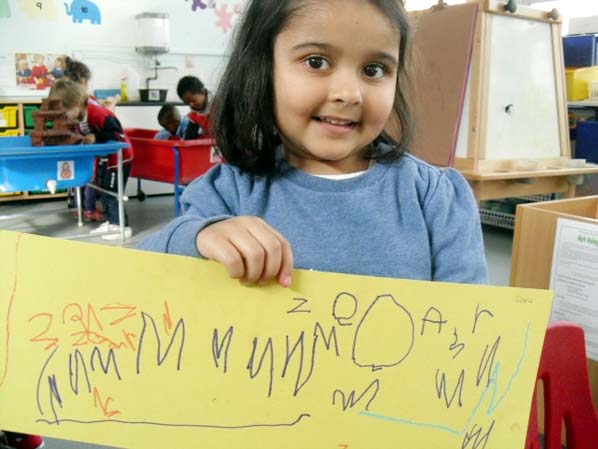
Reed Markham :
Toni Bickart, author of WHAT EVERY PARENTS NEEDS TO KNOW ABOUT FIRST, SECOND, AND THIRD GRADES observed: “The process of learning how to write begins at a very early age. Young children, using crayons or markers, write with great enthusiasm and eagerness. Toddlers and preschoolers think that all they have to do is pick up a pen and scrawl little lines and dots.
Gradually, they realize that writing is speech in the form of symbols on paper, so they talk and scribble away and expect you to read this scribble. As their fine motor skills develop, children draw pictures and dictate words to accompany the pictures. Sometimes they try to write words. They may start with words they remember seeing somewhere, or they may attempt to write the sounds they hear when they say the words aloud. For example, a child might write “d” or DG” for “DOG.” From these modest but enthusiastic beginnings, writers emerge.”
The following advice will help your child develop strong writing skills:
First, encourage writing at home. Bernard Ryan, author of HELPING YOUR CHILD START SCHOOL concluded: “Children get a big kick out of writing their own stories and poems, even jokes and riddles. Encourage your child to write by making sure he has paper, pencils, and pens. If you have a computer in the house, introduce him to your word-processing program. Writing also calls for listening to books read aloud, so your child hears ideas expressed in sentences that move along into narratives. Keep reading aloud. You provide several messages when you read to your child. You show respect for the written word. You provide a warm, intimate experience that is particularly enjoyable, especially in the winding-down time before bed. Keep the praise flowing. Read your child’s stories, project papers, and book reports, but read conscientiously and praise honestly. Point out what is well done before you belabor the weaknesses, for encouragement is vital food for the writer.”
Second, create a list of at-home writing activities. Bickart urges parents to include the following items on their list:
*message board- put up a message board family members can write messages to each other
*diary- give your child a diary or a calendar with space to write or word or two about what happened each day
*discuss writing- when interesting or funny things happen, talk with your child about how you could write stories about these events- begin by saying the first line, have your child say the next, and keep alternating until you have finished the story
*photo captions- invite your child to write captions for pictures in a family photo album
Third, encourage your child’s teacher to develop an online newspaper. A classroom newspaper can provide kids with wonderful writing opportunities.
Your child’s teacher should consider membership in the National Elementary Schools Press Association (NESPA). This organization is dedicated to helping elementary and middle schools start a newspaper. Check out the excellent resources on the NESPA web site: http://nespa.ua.edu.
Toni Bickart, author of WHAT EVERY PARENTS NEEDS TO KNOW ABOUT FIRST, SECOND, AND THIRD GRADES observed: “The process of learning how to write begins at a very early age. Young children, using crayons or markers, write with great enthusiasm and eagerness. Toddlers and preschoolers think that all they have to do is pick up a pen and scrawl little lines and dots.
Gradually, they realize that writing is speech in the form of symbols on paper, so they talk and scribble away and expect you to read this scribble. As their fine motor skills develop, children draw pictures and dictate words to accompany the pictures. Sometimes they try to write words. They may start with words they remember seeing somewhere, or they may attempt to write the sounds they hear when they say the words aloud. For example, a child might write “d” or DG” for “DOG.” From these modest but enthusiastic beginnings, writers emerge.”
The following advice will help your child develop strong writing skills:
First, encourage writing at home. Bernard Ryan, author of HELPING YOUR CHILD START SCHOOL concluded: “Children get a big kick out of writing their own stories and poems, even jokes and riddles. Encourage your child to write by making sure he has paper, pencils, and pens. If you have a computer in the house, introduce him to your word-processing program. Writing also calls for listening to books read aloud, so your child hears ideas expressed in sentences that move along into narratives. Keep reading aloud. You provide several messages when you read to your child. You show respect for the written word. You provide a warm, intimate experience that is particularly enjoyable, especially in the winding-down time before bed. Keep the praise flowing. Read your child’s stories, project papers, and book reports, but read conscientiously and praise honestly. Point out what is well done before you belabor the weaknesses, for encouragement is vital food for the writer.”
Second, create a list of at-home writing activities. Bickart urges parents to include the following items on their list:
*message board- put up a message board family members can write messages to each other
*diary- give your child a diary or a calendar with space to write or word or two about what happened each day
*discuss writing- when interesting or funny things happen, talk with your child about how you could write stories about these events- begin by saying the first line, have your child say the next, and keep alternating until you have finished the story
*photo captions- invite your child to write captions for pictures in a family photo album
Third, encourage your child’s teacher to develop an online newspaper. A classroom newspaper can provide kids with wonderful writing opportunities.
Your child’s teacher should consider membership in the National Elementary Schools Press Association (NESPA). This organization is dedicated to helping elementary and middle schools start a newspaper. Check out the excellent resources on the NESPA web site: http://nespa.ua.edu.

